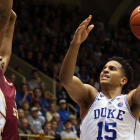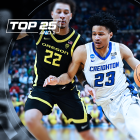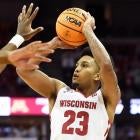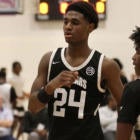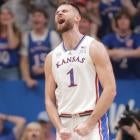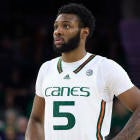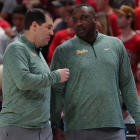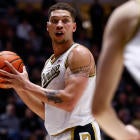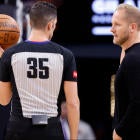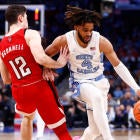Now that we know, for good, who is returning to college and who is staying in the NBA Draft, let's move on for a moment from teams and instead talk about the prospects -- particularly the players who are staying in this year's draft pool but might be making the wrong decision.
Before we go on, I do want to say that I think the NCAA's new timeline for deadline and evaluation allowance is working. Players now have until 10 days after the completion of the combine to make their choice, once and for all, on whether to return to school. This has been in place for two years, and what I'm finding is that most are making the right call. The feedback is being listened to. Nature is taking its course.
Of course, there are some exceptions. While many of the players listed below will be drafted, the common theme here is that they're leaving more-likely college potential on the table to chase NBA possibilities. It's not an easy decision, I know. With that in mind, here are 10 players who have signed an agent, but might have been better off -- in the long run -- squeezing in one more season of college basketball.
Tony Bradley | PF | North Carolina
Tony Bradley is purely taking a risk here, and it's a fascinating one. He's the first one-and-done player to come out of UNC in a decade (somewhat surprising, that). He wasn't one of UNC's five most important or impactful players last season, but he was set up to be a top-three guy if he came back for his sophomore year. That won't happen.
Now, this is not a bad decision by any means, but Bradley's likely to be a second-round pick this year after averaging 7.1 points and 5.1 rebounds in 14.6 minutes. His per-40 numbers, though, were great. He was clipping at 19.5 points and 14.1 rebounds in per-40, and his player efficiency rating (PER) was a healthy 26.1. He shot 56 percent from 2-point range (he took no 3s) and had a 123.2 offensive rating (per KenPom), so that's pretty good. Not elite, but nice.
Ultimately, Bradley -- I believe -- would have been picked higher in the 2018 draft than in 2017. I think his development and impact with UNC next season would have put him in position to earn more money a year from now. He'll be picked on potential, and maybe he winds up being a first-round surprise.
Frank Jackson | SG | Duke
I really have to wonder what Frank Jackson considered when he decided to be a one-and-done guy. Let's look at his situation.
He is a five-star shooting guard prospect who was a spot starter and became a very good, confident role player for Duke last season. Had he returned for a second season in Durham, I think he would have been a top-30 player. With that, he likely would have averaged north of 15 points, even with Grayson Allen in the mix. I was told that Jackson's decision was not influenced by Allen returning or the prospect of Trevon Duval committing to Duke, which subsequently happened following Jackson staying in the draft for good.
Jackson, who is 6-feet-4, averaged 10.9 points, 2.5 rebounds, 1.7 assists and shot 54 percent from 2 and 39 percent from 3-point range. He has good strength, a nice shooting form and doesn't lack for competitiveness. With a year of seasoning, he probably would have transformed into a first-round pick. Instead, he takes a chance now. When you're a guarantee to be drafted, it's hard to say making the call to stay in the draft is a "bad decision." But I do believe Jackson is taking a risk here because his potential probably would have garnered him a higher spot and more money in a weaker draft in 2018.
Harry Giles | PF | Duke
Giles only qualifies as a risk because of the nature of his knee injuries. He is a walking risk. He had to go because, well what if he made no strides as a sophomore? His stock would only crater. Giles has had two major knee operations following ACL tears, and last October had his left knee scoped. He averaged 3.9 points and 3.8 rebounds in spot play last season. He saw the floor in 26 of Duke's 37 games. He is risk personified. But if he hits? If he can become even 85 percent of the player that he was as a high school prospect? He will be the steal of the 2017 draft. Giles could be taken anywhere from 24th to 44th.
P.J. Dozier | SG | South Carolina
The South Carolina sophomore is taking advantage of a Final Four run and hoping he can stick with a solid franchise. I find his case somewhat similar to Frank Jackson. I think one more year of college would have significantly bumped his draft position. Dozier was second fiddle last season to Sindarius Thornwell, a do-it-all player who was a CBS Sports first-team All-American. While Thornwell carried the heaviest load for the Gamecocks, Dozier averaged 13.9 points, 3.9 rebounds, 2.4 assists and 1.7 steals. He was not an efficient player, though. He shot 45 percent from 2 and 30 percent from 3. His PER was C-level: 17.5.
Dozier will probably be drafted, but he'll go no higher than 45th. He's a smooth player with a 6-11 wingspan, so he has physical tools to be an NBA role player. However, South Carolina would have relied on him heavily next season and it's likely he could have competed to be the SEC Player of the Year. You combine a year of being the go-to guy with 12 more months of development, and Dozier could have had a chance to be a first-round pick.
Edmond Sumner | PG | Xavier
Sumner's season ended in January when he tore his left ACL. Before the injury, he was projected as a first-round pick. In the latest round of post-deadline mock drafts, Sumner is firmly in the 40-or-lower category. Is it just the injury? Well, that's a lot of it. ACL tears for guards aren't seen as big-time red flags anymore, not the way they were even a decade ago. But Sumner has not been able to work out. Without teams getting to see his physical capabilities so close to the draft, he's essentially losing millions of dollars and a guaranteed contract.
Was Sumner advised of this when he made his decision to stay in the pool? If he would have opted to rehab and return to Xavier, the Musketeers would have been a borderline top-10 team in 2017-18, and a strong return for Sumner could have kept him in the first round of the 2018 draft. So, yes, this is certainly a risky call for him. But after going down with the type of injury he did, it's understandable why he wants to chase being a pro.
Kobi Simmons | PG | Arizona
Simmons was the forgotten freshman point guard in the year of the freshman point guard. If he gets picked, he'll be in the mid-50s at best, probably. Simmons is long and lean but was a nonfactor for much of Arizona's season. He didn't have nearly the statistical relevance as Lonzo Ball, Dennis Smith Jr., De'Aaron Fox or Markelle Fultz. So, yeah, when you leave a top-10 program after just one year and are not guaranteed to be drafted, that's the definition of a risky call. Particularly when you were a five-star prospect. The devil is in the details for Simmons, though. Would he have been a markedly bigger factor for Arizona next season if he stayed? In 2016-17, Simmons averaged 8.8 points and two assists in 23.5 minutes and shot 43.5 percent from 2-point range. He is 6-4 with a 6-6 wingspan. Most alarming was his 11.5 PER. Simmons might well have been overhyped from the time he was 16, unfortunately.
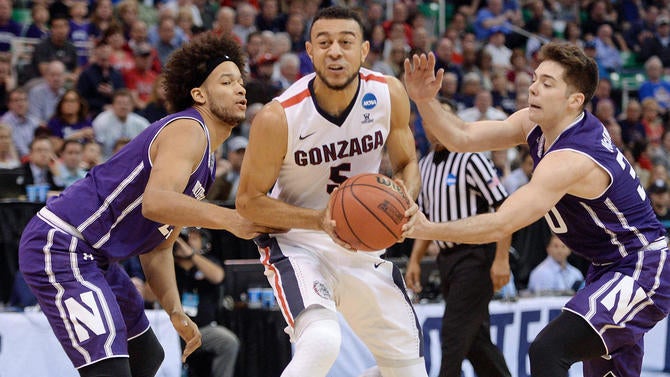
Nigel Williams-Goss | SG | Gonzaga
There is no player in this year's draft who would have been a better player in college next season than Williams-Goss. He vacillated in previous season on going, so to see him decide to leave now -- as he'll be 23 by the time the NBA season starts -- it's not a shocker. It's not a bad call, either. But considering Williams-Goss is also not a guaranteed draft pick, consider the alternative.
Had Williams-Goss come back, he would have been the preseason pick for national player of the year. Gonzaga would have been close to a top-10 team and by nature of getting Williams-Goss back, the Zags could have hoped for a repeat Final Four showing. If he came back and even equaled his 2016-17 averages (16.8 points, six rebounds, 4.7 assists, 1.7 steals in 32.8 minutes), he would have reinforced his NBA résumé. And, say it with me again, in a weaker draft in 2018 it's reasonable to believe Williams-Goss could have bumped up into the 40s rather than being a fringe pick in 2017.
Eric Mika | PF | BYU
Mika turned BYU's 2017-18 prospectus by opting to stay in the draft. A dynamic big man at the college level, Mika is a toss-up to be picked this year. He averaged 20.3 points and 9.2 rebounds for the Cougars last season. That came after his two-year mission. Mika was in a tough spot, because he played himself into prospect territory while losing two years due to his mission. Had he come back and posted similar numbers, it's probable his stock would not have jumped.
But it's not guaranteed. So there is some risk here. Not a lot, but it's still there.
Isaiah Briscoe | PG | Kentucky
Briscoe averaged 14 points, 5.5 assist and three rebounds while shooting 50.7 from 2-point range and making a big jump as a sophomore. But his game and performance through two seasons with the Wildcats hasn't convinced a number of scouts and general managers that he's an NBA-level player. Briscoe, who has a great 6-9 wingspan to accommodate his 6-3 frame, is likely going to get caught in a numbers game in this year's draft.
He's a point guard who lacks the physical quickness of most NBA point guards, and he doesn't have the 3-point shot to establish himself as even a B-level offensive threat. Could he grow into that kind of player? I think Briscoe has a ceiling but ultimately would have helped himself by coming back to Kentucky for one more season and acting as the undisputed leader and veteran on a team that will desperately need such a presence. Briscoe could have become a guy capable of being responsible of 40 percent of Kentucky's points (via his own buckets and assists) and if his usage rate and efficiency shot up, he would have had a chance at getting drafted in 2018.
Marcus Keene | PG | Central Michigan
I was bummed to see Keene walk away from college ball. He would have been one of the most enjoyable and interesting stories had he decided to stay. He led college basketball in scoring last season, putting up 30 points per game in addition to 4.9 assists and 4.5 rebounds. Keene became the first Division I player in 20 years to average 30 points.
He was relatively efficient, too, hitting 36.8 percent of his 3-pointers and 52.2 percent of his 2-pointers. Keene became more well-known as the season went along, but that was nothing compared to the publicity he would have received if he had come back. Preseason All-American was not out of the question. Another year of dominance, even if at a smaller school, would have brought him more recognition and higher demand in the overseas market. Keene has no shot of being drafted, as he's 5-9 and 22 years old.
It's not a risky move, so to speak, for him to sign with an agent and move on. But had he returned, CMU could have had a really good chance of going to the NCAAs, and Keene might have become one of the most discussed players in college basketball in 2017-18.












